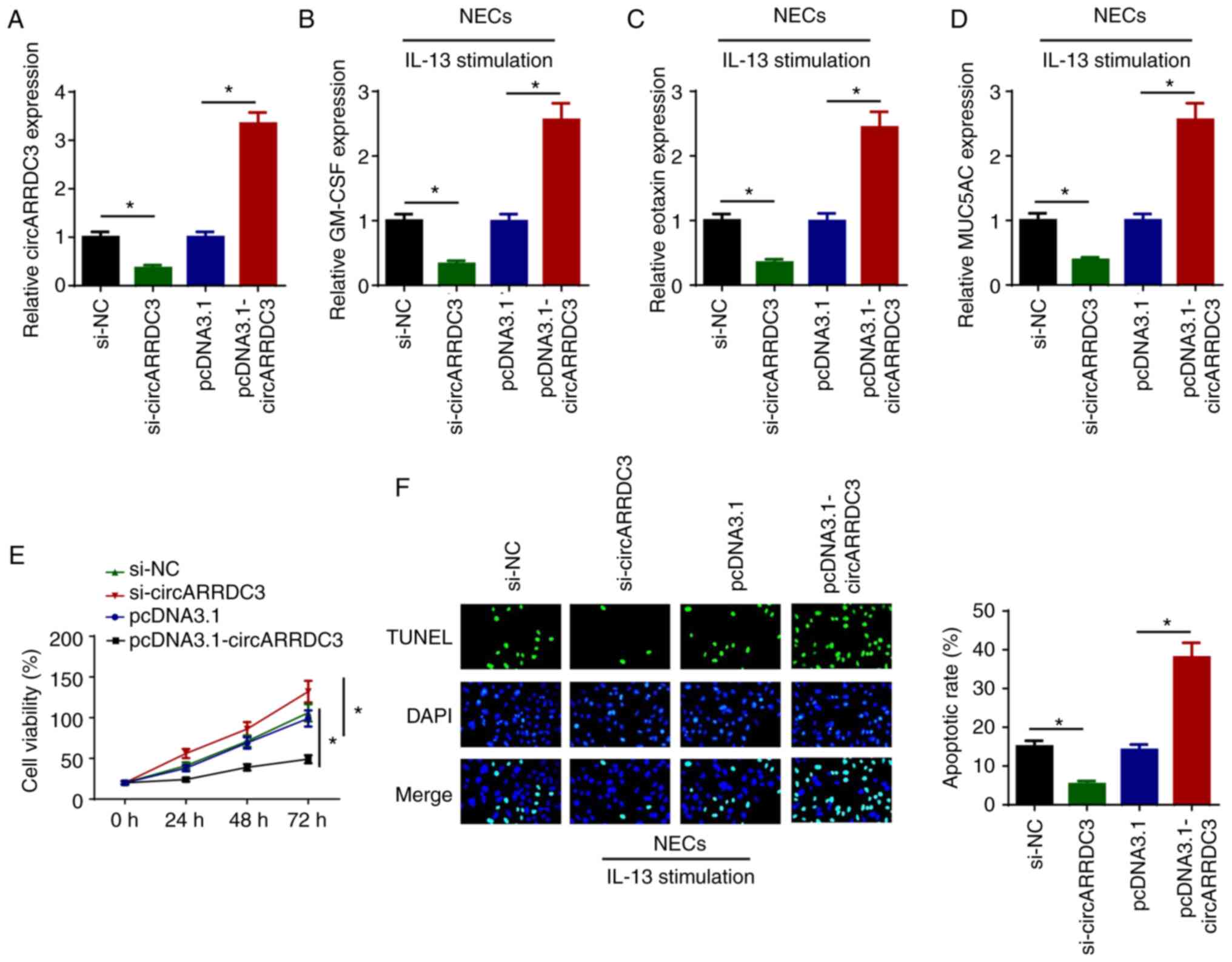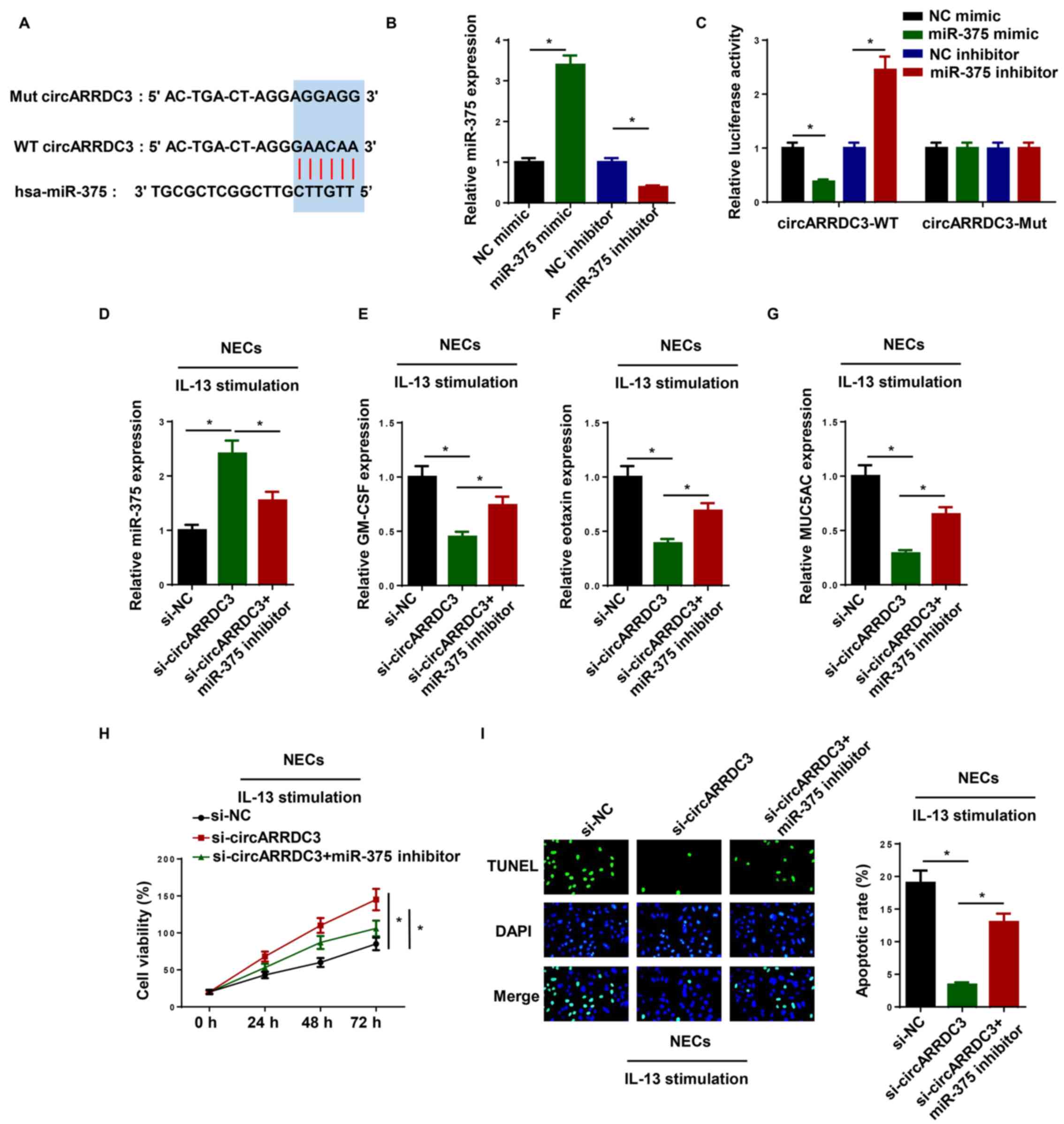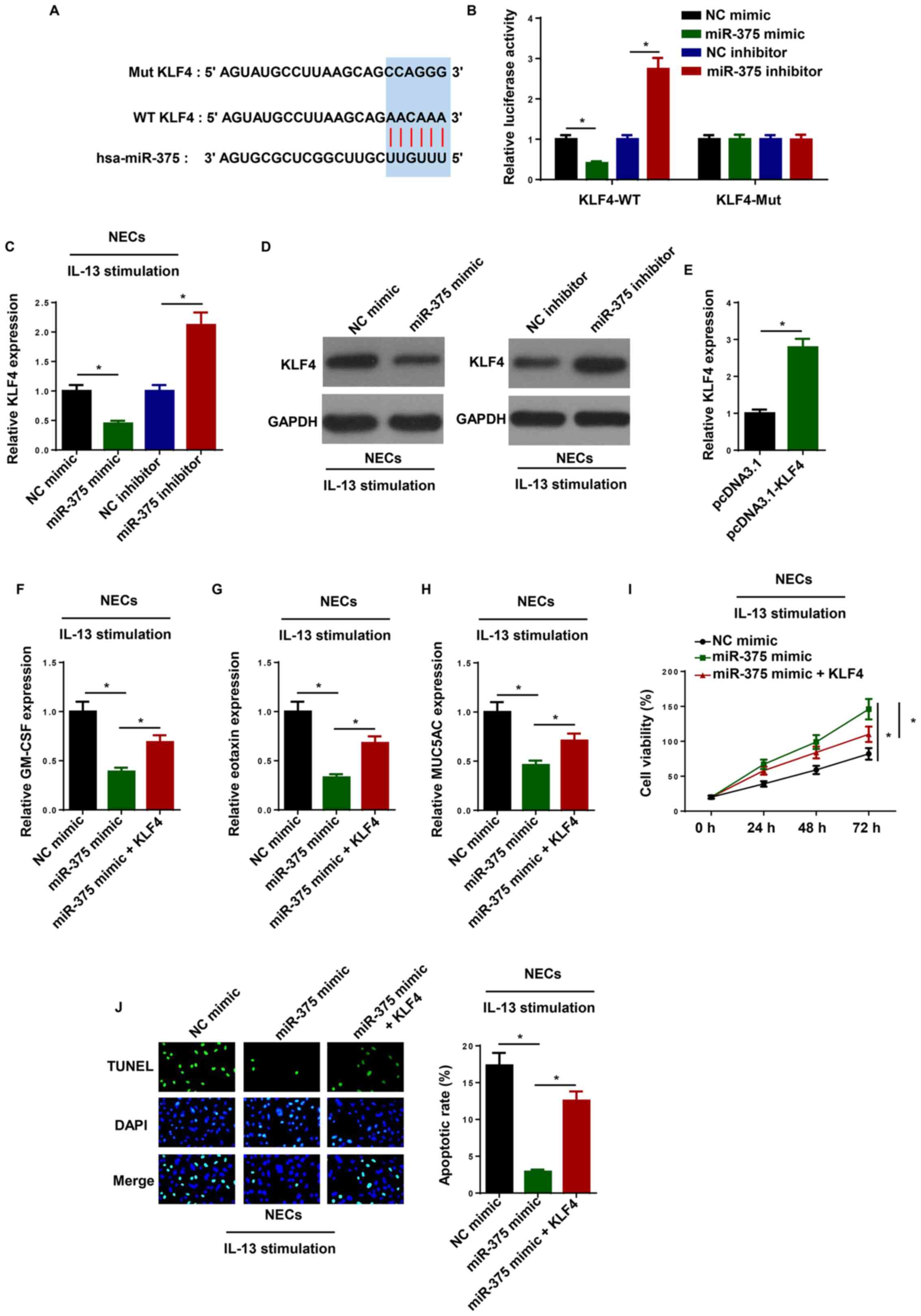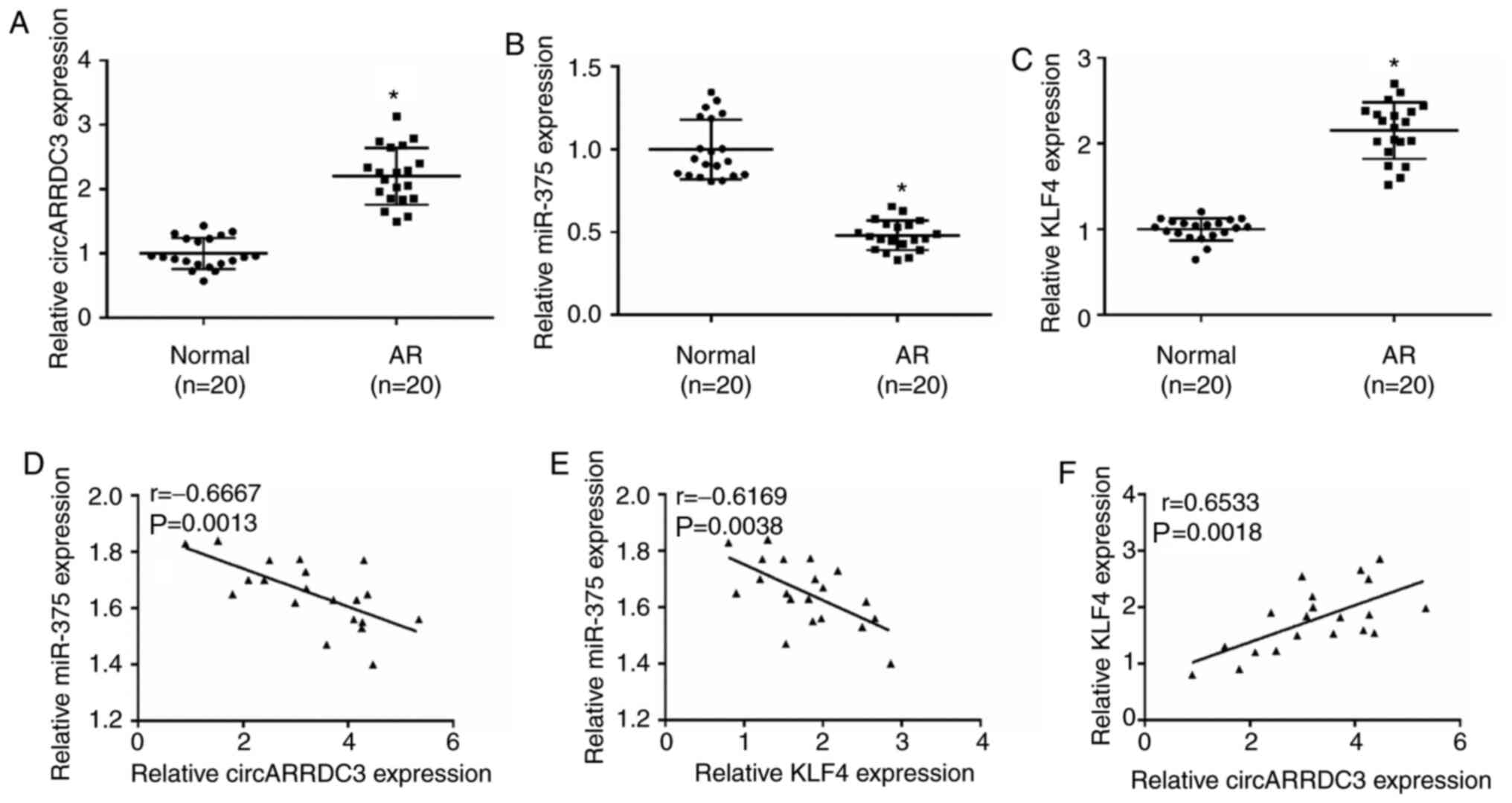|
1
|
Ozdoganoglu T and Songu M: The burden of
allergic rhinitis and asthma. Ther Adv Respir Dis. 6:11–23. 2012.
View Article : Google Scholar : PubMed/NCBI
|
|
2
|
Bauchau V and Durham SR: Epidemiological
characterization of the intermittent and persistent types of
allergic rhinitis. Allergy. 60:350–353. 2005. View Article : Google Scholar : PubMed/NCBI
|
|
3
|
Leynadier F, Mees K, Arendt C and Pinelli
ME: Efficacy and safety of levocetirizine in seasonal allergic
rhinitis. Acta Otorhinolaryngol Belg. 55:305–312. 2001.PubMed/NCBI
|
|
4
|
Wang DY: Risk factors of allergic
rhinitis: Genetic or environmental? Ther Clin Risk Manag.
1:115–123. 2005. View Article : Google Scholar : PubMed/NCBI
|
|
5
|
Memczak S, Jens M, Elefsinioti A, Torti F,
Krueger J, Rybak A, Maier L, Mackowiak SD, Gregersen LH, Munschauer
M, et al: Circular RNAs are a large class of animal RNAs with
regulatory potency. Nature. 495:333–338. 2013. View Article : Google Scholar : PubMed/NCBI
|
|
6
|
Liu J and Cao Z: Protective Effect of
Circular RNA (CircRNA) Ddx17 in Ovalbumin (OVA)-Induced Allergic
Rhinitis (AR) Mice. Med Sci Monit. 26:e9190832020.PubMed/NCBI
|
|
7
|
Zhu X, Wang X, Wang Y and Zhao Y: The
regulatory network among CircHIPK3, LncGAS5, and miR-495 promotes
Th2 differentiation in allergic rhinitis. Cell Death Dis.
11:2162020. View Article : Google Scholar : PubMed/NCBI
|
|
8
|
Yue L, Yin X, Hao F, Dong J, Ren X, Xu O
and Shan C: Long noncoding RNA Linc00632 inhibits
interleukin-13-induced inflammatory cytokine and mucus production
in nasal epithelial cells. J Innate Immun. 12:116–128. 2020.
View Article : Google Scholar : PubMed/NCBI
|
|
9
|
Shin IS, Lee MY, Jeon WY, Shin NR, Seo CS
and Ha H: EBM84 attenuates airway inflammation and mucus
hypersecretion in an ovalbumin-induced murine model of asthma. Int
J Mol Med. 31:982–988. 2013. View Article : Google Scholar : PubMed/NCBI
|
|
10
|
Wang L, Lv Q, Song X, Jiang K and Zhang J:
ADRB2 suppresses IL-13-induced allergic rhinitis inflammatory
cytokine regulated by miR-15a-5p. Hum Cell. 32:306–315. 2019.
View Article : Google Scholar : PubMed/NCBI
|
|
11
|
Carleton M, Cleary MA and Linsley PS:
MicroRNAs and cell cycle regulation. Cell Cycle. 6:2127–2132. 2007.
View Article : Google Scholar : PubMed/NCBI
|
|
12
|
Chen S, Liu Y, Wang Y and Xue Z: LncRNA
CCAT1 promotes colorectal cancer yumorigenesis via a
miR-181b-5p/TUSC3 axis. OncoTargets Ther. 12:9215–9225. 2019.
View Article : Google Scholar
|
|
13
|
Teng Y, Zhang R, Liu C, Zhou L, Wang H,
Zhuang W, Huang Y and Hong Z: miR-143 inhibits
interleukin-13-induced inflammatory cytokine and mucus production
in nasal epithelial cells from allergic rhinitis patients by
targeting IL13Rα1. Biochem Biophys Res Commun. 457:58–64. 2015.
View Article : Google Scholar : PubMed/NCBI
|
|
14
|
Liu HC, Liao Y and Liu CQ: miR-487b
mitigates allergic rhinitis through inhibition of the IL-33/ST2
signaling pathway. Eur Rev Med Pharmacol Sci. 22:8076–8083.
2018.PubMed/NCBI
|
|
15
|
Chen RF, Huang HC, Ou CY, Hsu TY, Chuang
H, Chang JC, Wang L, Kuo HC and Yang KD: MicroRNA-21 expression in
neonatal blood associated with antenatal immunoglobulin E
production and development of allergic rhinitis. Clin Exp Allergy.
40:1482–1490. 2010. View Article : Google Scholar : PubMed/NCBI
|
|
16
|
Dissanayake E and Inoue Y: MicroRNAs in
allergic disease. Curr Allergy Asthma Rep. 16:672016. View Article : Google Scholar : PubMed/NCBI
|
|
17
|
Ingram JL and Kraft M: IL-13 in asthma and
allergic disease: Asthma phenotypes and targeted therapies. J
Allergy Clin Immunol. 130:829–842; quiz 843–844. 2012. View Article : Google Scholar : PubMed/NCBI
|
|
18
|
Lv J, Xiong Y, Li W, Cui X, Cheng X, Leng
Q and He R: IL-37 inhibits IL-4/IL-13-induced CCL11 production and
lung eosinophilia in murine allergic asthma. Allergy. 73:1642–1652.
2018. View Article : Google Scholar : PubMed/NCBI
|
|
19
|
Ashraf MI, Shahzad M and Shabbir A:
Oxyresveratrol ameliorates allergic airway inflammation via
attenuation of IL-4, IL-5, and IL-13 expression levels. Cytokine.
76:375–381. 2015. View Article : Google Scholar : PubMed/NCBI
|
|
20
|
Zhu X, Wang X, Wang Y and Zhao Y: Exosomal
long non-coding RNA GAS5 suppresses Th1 differentiation and
promotes Th2 differentiation via downregulating EZH2 and T-bet in
allergic rhinitis. Mol Immunol. 118:30–39. 2020. View Article : Google Scholar : PubMed/NCBI
|
|
21
|
Agarwal V, Bell GW, Nam JW and Bartel DP:
Predicting effective microRNA target sites in mammalian mRNAs.
eLife. 4:42015. View Article : Google Scholar
|
|
22
|
Livak KJ and Schmittgen TD: Analysis of
relative gene expression data using real-time quantitative PCR and
the 2(-Delta Delta C(T)) method. Methods. 25:402–408. 2001.
View Article : Google Scholar : PubMed/NCBI
|
|
23
|
Hwang JY, Kim EB, Ka H and Lee CK:
Identification of the porcine XIST gene and its differential CpG
methylation status in male and female pig cells. PLoS One.
8:e736772013. View Article : Google Scholar : PubMed/NCBI
|
|
24
|
Shenoda BB, Tian Y, Alexander GM,
Aradillas-Lopez E, Schwartzman RJ and Ajit SK: miR-34a-mediated
regulation of XIST in female cells under inflammation. J Pain Res.
11:935–945. 2018. View Article : Google Scholar : PubMed/NCBI
|
|
25
|
Qin L, Lin J and Xie X: CircRNA-9119
suppresses poly I:C induced inflammation in Leydig and Sertoli
cells via TLR3 and RIG-I signal pathways. Mol Med. 25:282019.
View Article : Google Scholar : PubMed/NCBI
|
|
26
|
Yang H, Wang H, Shang H, Chen X, Yang S,
Qu Y, Ding J and Li X: Circular RNA circ_0000950 promotes neuron
apoptosis, suppresses neurite outgrowth and elevates inflammatory
cytokines levels via directly sponging miR-103 in Alzheimer's
disease. Cell Cycle. 18:2197–2214. 2019. View Article : Google Scholar : PubMed/NCBI
|
|
27
|
Ye YL, Yin J, Hu T, Zhang LP, Wu LY and
Pang Z: Increased circulating circular RNA_103516 is a novel
biomarker for inflammatory bowel disease in adult patients. World J
Gastroenterol. 25:6273–6288. 2019. View Article : Google Scholar : PubMed/NCBI
|
|
28
|
Zhang Z, Zhang T, Feng R, Huang H, Xia T
and Sun C: circARF3 alleviates mitophagy-mediated inflammation by
targeting miR-103/TRAF3 in mouse adipose tissue. Mol Ther Nucleic
Acids. 14:192–203. 2019. View Article : Google Scholar : PubMed/NCBI
|
|
29
|
Xue H, Yu F, Zhang X, Liu L and Huang L:
circ_0000638 inhibits neodymium oxide-induced bronchial epithelial
cell inflammation through the miR-498-5p/NF-κB axis. Ecotoxicol
Environ Saf. 195:1104552020. View Article : Google Scholar : PubMed/NCBI
|
|
30
|
Wang T, Chen D, Wang P, Xu Z and Li Y:
miR-375 prevents nasal mucosa cells from apoptosis and ameliorates
allergic rhinitis via inhibiting JAK2/STAT3 pathway. Biomed
Pharmacother. 103:621–627. 2018. View Article : Google Scholar : PubMed/NCBI
|
|
31
|
Segre JA, Bauer C and Fuchs E: Klf4 is a
transcription factor required for establishing the barrier function
of the skin. Nat Genet. 22:356–360. 1999. View Article : Google Scholar : PubMed/NCBI
|
|
32
|
Tiwari N, Meyer-Schaller N, Arnold P,
Antoniadis H, Pachkov M, van Nimwegen E and Christofori G: Klf4 is
a transcriptional regulator of genes critical for EMT, including
Jnk1 (Mapk8). PLoS One. 8:e573292013. View Article : Google Scholar : PubMed/NCBI
|
|
33
|
Kurotaki D, Osato N, Nishiyama A, Yamamoto
M, Ban T, Sato H, Nakabayashi J, Umehara M, Miyake N, Matsumoto N,
et al: Essential role of the IRF8-KLF4 transcription factor cascade
in murine monocyte differentiation. Blood. 121:1839–1849. 2013.
View Article : Google Scholar : PubMed/NCBI
|
|
34
|
Liu Y, Shi J and Chen X: Identification of
novel targets for seasonal allergic rhinitis during and outside the
pollen season by microarray analysis. Acta Otolaryngol.
135:1330–1336. 2015. View Article : Google Scholar : PubMed/NCBI
|
|
35
|
Mao Q, Quan T, Luo B, Guo X, Liu L and
Zheng Q: MiR-375 targets KLF4 and impacts the proliferation of
colorectal carcinoma. Tumour Biol. 37:463–471. 2016. View Article : Google Scholar : PubMed/NCBI
|


















